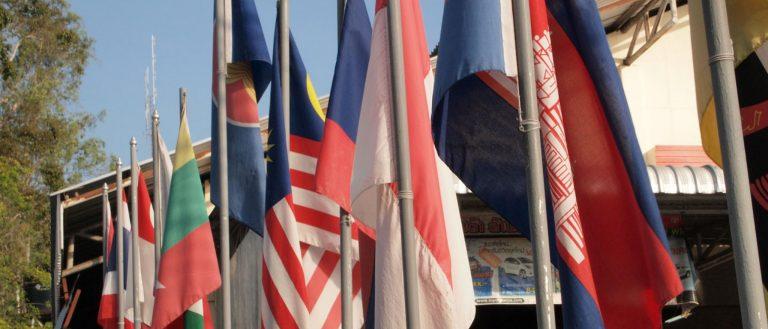Photo Credits: ISPI
Published by ISPI on November 12.
In a world where great power rivalry is seemingly overtaking the multilateral world order, a regional organisation with lofty ideals such as “One vision, one identity, one community”, seems anachronistic. However, looking at the 35th ASEAN Summit in Bangkok, it looks like Southeast Asia is feeling quite at ease in the current state of affairs. There are some serious concerns, of course, not in the least regarding the security threats in the South China Sea (SCS). Nonetheless, the general trend was optimistic.
Although president Donald Trump always stood by his pledge that winning a trade war is “easy”, trade talks between the U.S. and China have reached a deadlock with no end in sight yet. With growth margins decreasing – largely due to a slump in its domestic consumer spending – the economic outlook for China has appeared increasingly gloomy. In the short term, the weakening of China – that is, ASEAN’s largest trading partner – had some negative consequences for Southeast Asia, the growth rate of which has been lowered to 5.4 for 2020 by the Asian Development Bank. In the long term, however, it might prove to be the perfect storm for ASEAN – and it seems that at the Bangkok Summit ASEAN leaders were aware of this.
Vietnam and Malaysia, for example, are steadily gaining more traction as manufacturing hubs and trading centres, as investments and supply chains are diverting from the Pearl River Delta to the shores of the Mekong and Klang. Uproar in Hong Kong, on the other hand, might be an opportunity for Singapore to take Hong Kong’s place as the main trading centre in Asia.
In order to affirm Southeast Asia as a trading hub and strengthen ties with its partners, the “Regional Comprehensive Economic Partnership” (RCEP) was put high on the agenda. The initially 16-nation wide RCEP spanning from India to New Zealand, with Southeast Asia at the geographical centre, was meant to be finalised at the Bangkok Summit. The negotiations, however, ended in a modest disappointment as India dropped out of the negotiations due to concerns over cheap Chinese imports.
The U.S., vastly underrepresented at the summit, did not seem too impressed with what has long been dubbed as “the Chinese Trans-Pacific Partnership”. U.S. Secretary of Commerce Wilbur Ross downplayed the importance of RCEP, saying that “it’s a very low-grade treaty”. And frankly, he has a point because the RCEP remains an incredibly “loose” cooperative framework that is mainly aimed to link economies rather than establish a free trade area, as the Trans-Pacific Partnership (TPP) was meant to do. Moreover, it does not ensure exclusivity, in the sense that members are not precluded to enter other trade agreements, thus de facto opposing the general narrative on decoupling.
Notwithstanding general fears that a trade vacuum for China would be created by the withdrawing from the TPP, the U.S. has actually weakened China’s bargaining power vis-à-vis ASEAN by waging a trade war. Optics matter, but while images are shared of China’s premier Li Keqiang shaking hands “the ASEAN way” with his Southeast Asian counterparts, at the end of the day RCEP does not have the strength to become the major deal breaker that the TTP was meant to be. China’s prominence in Bangkok can even be interpreted as a sign of weakness: in dire need for friend and markets, Beijing hails even a vague trade pact as a geopolitical win.
This does not mean that the U.S. has lost its position in Southeast Asia. Just that as it was the case with the “North America Free Trade Agreement” (NAFTA), the remaining architecture of the TPP has the potential to be resurrected relatively easily in all but name, putting the U.S. back in the driver’s seat. This would be a win-win scenario for ASEAN, as this would allow Malaysian premier Mohamad Mahathir & Co to do what they do best: pitting the great powers against each other.
In a world where superpowers and great powers are keeping each other in check, the widest room for manoeuvre is preserved for the middle-powers. Especially ASEAN, a regional organisation with just the right amount of integration to keep its members’ interests aligned, whilst remaining institutionally agile and adaptable, with a large degree of independence to its member states. A good fit for a post-Westphalian world – probably better than its European regional equivalent.
Looking back to the summit and Thailand’s chairmanship, intra-ASEAN issues such as the Rakhine conflict, were pushed unsurprisingly to the margins and a strong outward focus was maintained. With Vietnam taking over the chairmanship next year, this tendency is unlikely to change. However, we can expect a more security-oriented ASEAN, with a harsher tone for the challenges posed by the SCS.
How this will play out, will depend on how ASEAN’s neighbours and the U.S. will position themselves. Will China’s growth rates continue to decrease? Will the TPP be revisited by the U.S.? How will Indian premier Narendra Modi’s foreign policy in his second term unfold? A lot of known unknowns are going to play out in the region. Notwithstanding, one thing is for sure: ASEAN has become a world player to be reckoned with, and it is here to stay.
Author: Victor De Decker, Associate Researcher, European Institute for Asian Studies

